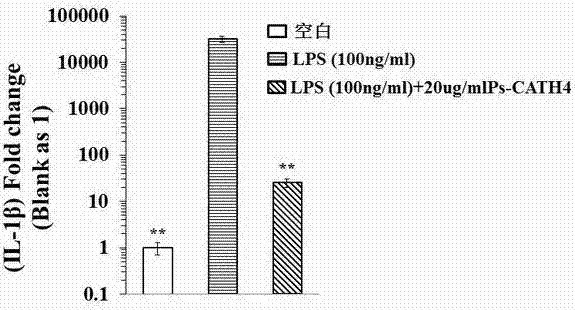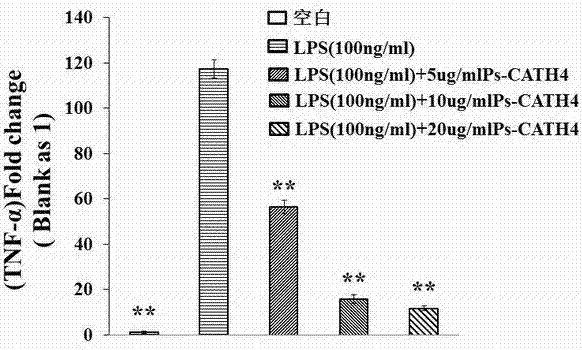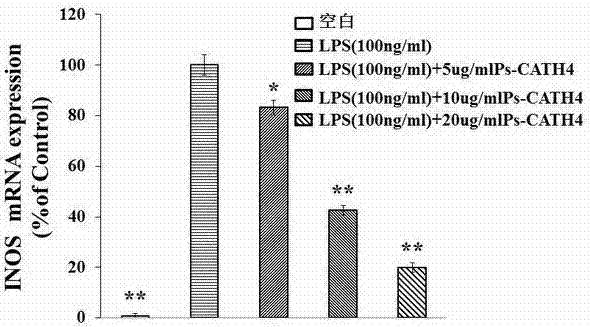Application of Chinese soft-shelled turtle cathelicidin-ps-cath4 peptide in the preparation of anti-inflammatory drugs
A ps-cath4, Chinese soft-shelled turtle technology, applied in the field of biomedicine, can solve the problems of no reports, and achieve the effects of simple structure, low cytotoxicity and hemolytic activity, and good stability
- Summary
- Abstract
- Description
- Claims
- Application Information
AI Technical Summary
Problems solved by technology
Method used
Image
Examples
Embodiment 1
[0057] Example 1 Ps-CATH4 peptide inhibits LPS-induced inflammatory cytokine and NO synthase (INOS) gene expression
[0058] Mouse macrophages RAW264.7 were treated with DMEM medium containing 10% fetal bovine serum at 37˚C CO 2 Cultivate in an incubator. When the cells grow to a good logarithmic growth phase, they are digested with 0.25% trypsin, discarded, and blown down adherent cells with DMEM medium with 10% fetal bovine serum. Count the cells after pipetting and adjust the cell concentration to 1x10 6 / ml. Add the evenly pipetted cells to a 24-well plate, 1ml per well, at 37˚C CO 2 Culture overnight in an incubator to make the cells adhere to the wall, then aspirate the supernatant and discard it, add 960ul of fresh DMEM medium containing 10% fetal bovine serum, add 20ul of a certain concentration of LPS to the positive control group and the dosing group, and then add 20ul of Ps-CATH4 diluted with DMEM and filtered and sterilized with different concentrations of Ps-CATH4...
Embodiment 2
[0060] Example 2 Ps-CATH4 peptide regulates the secretion of LPS-induced cellular inflammatory factors and NO in vitro
[0061] Mouse macrophages RAW264.7 were cultured in DMEM medium containing 10% fetal bovine serum to the logarithmic growth phase. After trypsinization, they were seeded in 96-well plates, 1x10 per well 6 One. CO at 37 ˚C 2 Incubate overnight in an incubator to make the cells adherent. After the cells adhere to the wall, discard the supernatant, add 180ul of fresh DMEM medium containing 10% fetal bovine serum to each well, and then add 10ul of Ps-CATH4 of different concentrations and 10ul of LPS of a certain concentration to each well, add blank 20ul serum-free DMEM medium, treated for 24h. The samples treated for 24 hours were used to collect the supernatant to detect the release of NO and inflammatory factors with Griess kit and ELISA kit, and 5 replicates were set for each experimental group. The Griess kit was purchased from Biyuntian Biological Reagent Co...
Embodiment 3
[0062] Example 3 Western blot method to detect the influence of Ps-CATH4 on MAPK inflammation signal pathway
[0063] Mouse macrophages RAW264.7 were cultured in DMEM medium containing 10% fetal bovine serum to the logarithmic growth phase. After digestion with trypsin, the cells were digested with 3x10 6 Pieces / ml were inoculated into 6-well plates, 2ml per well. CO at 37˚C 2 Incubate overnight in an incubator to make the cells adhere to the wall, then discard the upper cell culture medium, and use phosphate buffered saline (PBS: 0.8g NaCl; 0.2g KCl; 2.9gNa 2 HPO 4 .12H 2 O; 0.27g KH 2 PO 4 Dissolve in 800ml deionized water, stir to dissolve, make the volume to 1L, adjust the pH to 7.4 with concentrated HCl, and autoclave. ) Wash the cells 2-3 times, change to serum-free DMEM medium and starve for 16h. Add 20ul samples of different concentrations to each well (make the final concentration of each well 5, 10, 20ug / ml), add 20ul serum-free DMEM to the blank, and after treatment fo...
PUM
 Login to View More
Login to View More Abstract
Description
Claims
Application Information
 Login to View More
Login to View More - R&D
- Intellectual Property
- Life Sciences
- Materials
- Tech Scout
- Unparalleled Data Quality
- Higher Quality Content
- 60% Fewer Hallucinations
Browse by: Latest US Patents, China's latest patents, Technical Efficacy Thesaurus, Application Domain, Technology Topic, Popular Technical Reports.
© 2025 PatSnap. All rights reserved.Legal|Privacy policy|Modern Slavery Act Transparency Statement|Sitemap|About US| Contact US: help@patsnap.com



